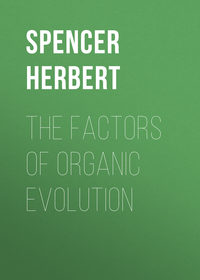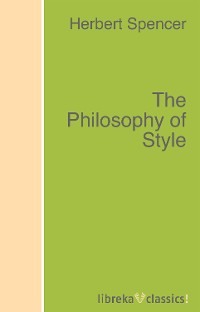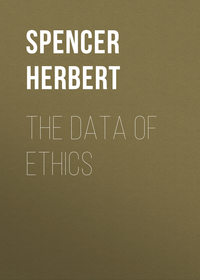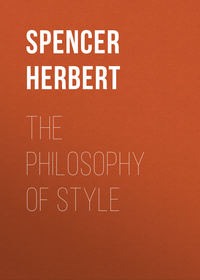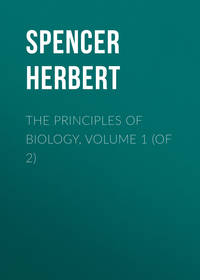 полная версия
полная версияFirst Principles
§ 126. The actions going on throughout an organism are so involved and subtle, that we cannot expect to identify the particular forces by which particular integrations are effected. Among the few instances admitting of tolerably definite interpretation, the best are those in which mechanical pressures and tensions are the agencies at work. We shall discover several on studying the bony frame of the higher animals.
The vertebral column of a man, is subject, as a whole, to certain general strains – the weight of the body, together with the reactions involved by all considerable muscular efforts; and in conformity with this, it has a certain general integration. At the same time, being exposed to different forces in the course of those lateral bendings which the movements necessitate, its parts retain a certain separateness. And if we trace up the development of the vertebral column from its primitive form of a cartilaginous cord in the lowest fishes, we see that, throughout, it maintains an integration corresponding to the unity of the incident forces, joined with a division into segments corresponding to the variety of the incident forces. Each segment, considered apart, exemplifies the truth more simply. A vertebra is not a single bone, but consists of a central mass with sundry appendages or processes; and in rudimentary types of vertebræ, those appendages are quite separate from the central mass, and, indeed, exist before it makes its appearance. But these several independent bones, constituting a primitive spinal segment, are subject to a certain aggregate of forces which agree more than they differ: as the fulcrum to a group of muscles habitually acting together, they perpetually undergo certain reactions in common. And accordingly, we see that in the course of development they gradually coalesce. Still clearer is the illustration furnished by spinal segments that become fused together where they are together exposed to some predominant strain. The sacrum consists of a group of vertebræ firmly united. In the ostrich and its congeners there are from seventeen to twenty sacral vertebræ; and besides being confluent with each other, these are confluent with the iliac bones, which run on each side of them. If now we assume these vertebræ to have been originally separate, as they still are in the embryo bird; and if we consider the mechanical conditions to which they must in such case have been exposed; we shall see that their union results in the alleged way. For through these vertebræ the entire weight of the body is transferred to the legs: the legs support the pelvic arch; the pelvic arch supports the sacrum; and to the sacrum is articulated the rest of the spine, with all the limbs and organs attached to it. Hence, if separate, the sacral vertebræ must be held firmly together by strongly-contracted muscles; and must, by implication, be prevented from partaking in those lateral movements which the other vertebræ undergo – they must be subject to a common strain, while they are preserved from strains which would affect them differently; and so they fulfil the conditions under which integration occurs. But the cases in which cause and effect are brought into the most obvious relation, are supplied by the limbs. The metacarpal bones (those which in man support the palm of the hand) are separate from each other in the majority of mammalia: the separate actions of the toes entailing on them slight amounts of separate movements. This is not so however in the ox-tribe and the horse-tribe. In the ox-tribe, only the middle metacarpals (third and fourth) are developed; and these, attaining massive proportions, coalesce to form the cannon bone. In the horse-tribe, the integration is what we may distinguish as indirect: the second and fourth metacarpals are present only as rudiments united to the sides of the third, while the third is immensely developed; thus forming a cannon bone which differs from that of the ox in being a single cylinder, instead of two cylinders fused together. The metatarsus in these quadrupeds exhibits parallel changes. Now each of these metamorphoses occurs where the different bones grouped together have no longer any different functions, but retain only a common function. The feet of oxen and horses are used solely for locomotion – are not put like those of unguiculate mammals to purposes which involve some relative movements of the metacarpals. Thus there directly or indirectly results a single mass of bone where the incident force is single. And for the inference that these facts have a causal connexion, we find confirmation throughout the entire class of birds; in the wings and legs of which, like integrations are found under like conditions. While this sheet is passing through the press, a fact illustrating this general truth in a yet more remarkable manner, has been mentioned to me by Prof. Huxley; who kindly allows me to make use of it while still unpublished by him. The Glyptodon, an extinct mammal found fossilized in South America, has long been known as a large uncouth creature allied to the Armadillo, but having a massive dermal armour consisting of polygonal plates closely fitted together so as to make a vast box, inclosing the body in such way as effectually to prevent it from being bent, laterally or vertically, in the slightest degree. This bony box, which must have weighed several hundred-weight, was supported on the spinous processes of the vertebræ, and on the adjacent bones of the pelvic and thoracic arches. And the significant fact now to be noted, is, that here, where the trunk vertebræ were together exposed to the pressure of this heavy dermal armour, at the same time that, by its rigidity, they were preserved from all relative movements, the entire series of them were united into one solid, continuous bone.
The formation and maintenance of a species, considered as an assemblage of similar organisms, is interpretable in an analogous way. We have already seen that in so far as the members of a species are subject to different sets of incident forces, they are differentiated, or divided into varieties. And here it remains to add that in so far as they are subject to like sets of incident forces, they are integrated, or reduced to, and kept in, the state of a uniform aggregate. For by the process of “natural selection,” there is a continual purification of each species from those individuals which depart from the common type in ways that unfit them for the conditions of their existence. Consequently, there is a continual leaving behind of those individuals which are in all respects fit for the conditions of their existence; and are therefore very nearly alike. The circumstances to which any species is exposed, being, as we before saw, an involved combination of incident forces; and the members of the species having mixed with them some that differ more than usual from the average structure required for meeting these forces; it results that these forces are constantly separating such divergent individuals from the rest, and so preserving the uniformity of the rest – keeping up its integrity as a species. Just as the changing autumn leaves are picked out by the wind from among the green ones around them, or just as, to use Prof. Huxley’s simile, the smaller fragments pass through the sieve while the larger are kept back; so, the uniform incidence of external forces affects the members of a group of organisms similarly in proportion as they are similar, and differently in proportion as they are different; and thus is ever segregating the like by parting the unlike from them. Whether these separated members are killed off, as mostly happens, or whether, as otherwise happens, they survive and multiply into a distinct variety, in consequence of their fitness to certain partially unlike conditions, matters not to the argument. The one case conforms to the law, that the unlike units of an aggregate are differentiated and integrated when uniformly subject to the same incident forces; and the other to the converse law, that the like units of an aggregate are differentiated and integrated when subject to different incident forces. And on consulting Mr. Darwin’s remarks on divergence of character, it will be seen that the segregations thus caused tend ever to become more definite.
§ 127. Mental evolution under one of its leading aspects, we found to consist in the formation of groups of like objects and like relations – a differentiation of the various things originally confounded together in one assemblage, and an integration of each separate order of things into a separate group (§ 113). Here it remains to point out that while unlikeness in the incident forces is the cause of such differentiations, likeness in the incident forces is the cause of such integrations. For what is the process through which classifications are established? At first, in common with the uninitiated, the botanist recognizes only such conventional divisions as those which agriculture has established – distinguishes a few vegetables and cereals, and groups the rest together into the one miscellaneous aggregate of wild plants. How do these wild plants become grouped in his mind into orders, genera, and species? Each plant he examines yields him a certain complex impression. Every now and then he picks up a plant like one before seen; and the recognition of it is the production in him of a like connected group of sensations, by a like connected group of attributes. That is to say, there is produced throughout the nerves concerned, a combined set of changes, similar to a combined set of changes before produced. Considered analytically, each such combined set of changes is a combined set of molecular modifications wrought in the affected part of the organism. On every repetition of the impression, a like combined set of molecular modifications is superposed on the previous ones, and makes them greater: thus generating an internal idea corresponding to these similar external objects. Meanwhile, another kind of plant produces in the brain of the botanist another set of combined changes or molecular modifications – a set which does not agree with and deepen the one we have been considering, but disagrees with it; and by repetition of such there is generated a different idea answering to a different species. What now is the nature of this process expressed in general terms? On the one hand there are the like and unlike things from which severally emanate the groups of forces by which we perceive them. On the other hand, there are the organs of sense and percipient centres, through which, in the course of observation, these groups of forces pass. In passing through these organs of sense and percipient centres, the like groups of forces are segregated, or separated from the unlike groups of forces; and each such differentiated and integrated series of groups of forces, answering to an external genus or species, constitutes a state of consciousness which we call our idea of the genus or species. We before saw that as well as a separation of mixed matters by the same force, there is a separation of mixed forces by the same matter; and here we may further see that the unlike forces so separated, work unlike structural changes in the aggregate that separates them – structural changes each of which thus represents, and is equivalent to, the integrated series of motions that has produced it.
By a parallel process, the connexions of co-existence and sequence among impressions, become differentiated and integrated simultaneously with the impressions themselves. When two phenomena that have been experienced in a given order, are repeated in the same order, those nerves which before were affected by the transition are again affected; and such molecular modification as they received from the first motion propagated through them, is increased by this second motion along the same route. Each such motion works a structural alteration, which, in conformity with the general law set forth in Chapter X., involves a diminution of the resistance to all such motions that afterwards occur. The integration of these successive motions (or more strictly, the permanently effective portions of them expended in overcoming resistance) thus becomes the cause of, and the measure of, the mental connexion between the impressions which the phenomena produce. Meanwhile, phenomena that are recognized as different from these, being phenomena that therefore affect different nervous elements, will have their connexions severally represented by motions along other routes; and along each of these other routes, the nervous discharges will severally take place with a readiness proportionate to the frequency with which experience repeats the connexion of phenomena. The classification of relations must hence go on pari passu with the classification of the related things. In common with the mixed sensations received from the external world, the mixed relations it presents, cannot be impressed on the organism without more or less segregation of them resulting. And through this continuous differentiation and integration of changes or motions, which constitutes nervous function, there is gradually wrought that differentiation and integration of matter, which constitutes nervous structure.
§ 128. In social evolution, the collecting together of the like and the separation of the unlike, by incident forces, is primarily displayed in the same manner as we saw it to be among groups of inferior creatures. The human races tend to differentiate and integrate, as do races of other living forms. Of the forces which effect and maintain the segregations of mankind, may first be named those external ones which we class as physical conditions. The climate and food that are favourable to an indigenous people, are more or less detrimental to a people of different bodily constitution, coming from a remote part of the Earth. In tropical regions the northern races cannot permanently exist: if not killed off in the first generation, they are so in the second; and, as in India, can maintain their footing only by the artificial process of continuous immigration and emigration. That is to say, the external forces acting equally on the inhabitants of a given locality, tend to expel all who are not of a certain type; and so to keep up the integration of those who are of that type. Though elsewhere, as among European nations, we see a certain amount of permanent intermixture, otherwise brought about, we still see that this takes place between races of not very different types, that are naturalized to not very different conditions. The other forces conspiring to produce these national integrations, are those mental ones which show themselves in the affinities of men for others like themselves. Emigrants usually desire to get back among their own people; and where their desire does not take effect, it is only because the restraining ties are too great. Units of one society who are obliged to reside in another, very generally form colonies in the midst of that other – small societies of their own. Races which have been artificially severed, show strong tendencies to re-unite. Now though these integrations that result from the mutual affinities of kindred men, do not seem interpretable as illustrations of the general principle above enunciated, they really are thus interpretable. When treating of the direction of motion (§ 91), it was shown that the actions performed by men for the satisfaction of their wants, were always motions along lines of least resistance. The feelings characterizing a member of a given race, are feelings which get complete satisfaction only among other members of that race – a satisfaction partly derived from sympathy with those having like feelings, but mainly derived from the adapted social conditions which grow up where such feelings prevail. When, therefore, a citizen of any nation is, as we see, attracted towards others of his nation, the rationale is, that certain agencies which we call desires, move him in the direction of least resistance. Human motions, like all other motions, being determined by the distribution of forces, it follows that such integrations of races as are not produced by incident external forces, are produced by forces which the units of the races exercise on each other.
During the development of each society, we see analogous segregations caused in analogous ways. A few of them result from minor natural affinities; but those most important ones which constitute political and industrial organization, result from the union of men in whom similarities have been produced by education – using education in its widest sense, as comprehending all processes by which citizens are moulded to special functions. Men brought up to bodily labour, are men who have had wrought in them a certain likeness – a likeness which, in respect of their powers of action, obscures and subordinates their natural differences. Those trained to brain-work, have acquired a certain other community of character which makes them, as social units, more like each other than like those trained to manual occupations. And there arise class-integrations answering to these superinduced likenesses. Much more definite integrations take place among the much more definitely assimilated members of any class who are brought up to the same calling. Even where the necessities of their work forbid concentration in one locality, as among artizans happens with masons and brick-layers, and among traders happens with the retail distributors, and among professionals happens with the medical men; there are not wanting Operative Builders Unions, and Grocers Societies, and Medical Associations, to show that these artificially-assimilated citizens become integrated as much as the conditions permit. And where, as among the manufacturing classes, the functions discharged do not require the dispersion of the citizens thus artificially assimilated, there is a progressive aggregation of them in special localities; and a consequent increase in the definiteness of the industrial divisions. If now we seek the causes of these integrations, considered as results of force and motion, we find ourselves brought to the same general principle as before. This likeness generated in any class or subclass by training, is an aptitude acquired by its members for satisfying their wants in like ways. That is, the occupation to which each man has been brought up, has become to him, in common with those similarly brought up, a line of least resistance. Hence under that pressure which determines all men to activity, these similarly-modified social units are similarly affected, and tend to take similar courses. If then there be any locality which, either by its physical peculiarities or by peculiarities wrought on it during social evolution, is rendered a place where a certain kind of industrial action meets with less resistance than elsewhere; it follows from the law of direction of motion that those social units who have been moulded to this kind of industrial action, will move towards this place, or become integrated there. If, for instance, the proximity of coal and iron mines to a navigable river, gives to Glasgow a certain advantage in the building of iron ships – if the total labour required to produce the same vessel, and get its equivalent in food and clothing, is less there than elsewhere; a concentration of iron-ship builders is produced at Glasgow: either by keeping there the population born to iron-ship building; or by immigration of those elsewhere engaged in it; or by both – a concentration that would be still more marked did not other districts offer counter-balancing facilities. The principle equally holds where the occupation is mercantile instead of manufacturing. Stock-brokers cluster together in the city, because the amount of effort to be severally gone through by them in discharging their functions, and obtaining their profits, is less there than in other localities. A place of exchange having once been established, becomes a place where the resistance to be overcome by each is less than elsewhere; and the pursuit of the course of least resistance by each, involves their aggregation around this place.
Of course, with units so complicated as those which constitute a society, and with forces so involved as those which move them, the resulting differentiations and integrations must be far more entangled, or far less definite, than those we have hitherto considered. But though there may be pointed out many anomalies which at first sight seem inconsistent with the alleged law, a closer study shows that they are but subtler illustrations of it. For men’s likenesses being of various kinds, lead to various order of integration. There are likenesses of disposition, likenesses of taste, likenesses produced by intellectual culture, likenesses that result from class-training, likenesses of political feeling; and it needs but to glance round at the caste-divisions, the associations for philanthropic, scientific, and artistic purposes, the religious parties and social cliques; to see that some species of likeness among the component members of each body determines their union. Now these different integrations, by traversing each other, and often by their indirect antagonism, more or less obscure each other; and prevent any one kind of integration from becoming complete. Hence the anomalies referred to. But if this cause of incompleteness be duly borne in mind, social segregations will be seen to conform entirely to the same principle as all other segregations. Analysis will show that either by external incident forces, or by what we may in a sense regard as mutual polarity, there are ever being produced in society integrations of those units which have either a natural likeness or a likeness generated by training.
§ 129. Can the general truth thus variously illustrated be deduced from the persistence of force, in common with foregoing ones? Probably the exposition at the beginning of the chapter will have led most readers to conclude that it can be so deduced.
The abstract propositions involved are these: – First, that like units, subject to a uniform force capable of producing motion in them, will be moved to like degrees in the same direction. Second, that like units if exposed to unlike forces capable of producing motion in them, will be differently moved – moved either in different directions or to different degrees in the same direction. Third, that unlike units if acted on by a uniform force capable of producing motion in them, will be differently moved – moved either in different directions or to different degrees in the same direction. Fourth, that the incident forces themselves must be affected in analogous ways: like forces falling on like units must be similarly modified by the conflict; unlike forces falling on like units must be dissimilarly modified; and like forces falling on unlike units must be dissimilarly modified. These propositions admit of reduction to a still more abstract form. They all of them amount to this: – that in the actions and reactions of force and matter, an unlikeness in either of the factors necessitates an unlikeness in the effects; and that in the absence of unlikeness in either of the factors the effects must be alike.
When thus generalized, the immediate dependence of these propositions on the persistence of force, becomes obvious. Any two forces that are not alike, are forces which differ either in their amounts or directions or both; and by what mathematicians call the resolution of forces, it may be proved that this difference is constituted by the presence in the one of some force not present in the other. Similarly, any two units or portions of matter which are unlike in size, weight, form, or other attribute, can be known by us as unlike only through some unlikeness in the forces they impress on our consciousness; and hence this unlikeness also, is constituted by the presence in the one of some force or forces not present in the other. Such being the common nature of these unlikenesses, what is the inevitable corollary? Any unlikeness in the incident forces, where the things acted on are alike, must generate a difference between the effects; since otherwise, the differential force produces no effect, and force is not persistent. Any unlikeness in the things acted on, where the incident forces are alike, must generate a difference between the effects; since otherwise, the differential force whereby these things are made unlike, produces no effect, and force is not persistent. While, conversely, if the forces acting and the things acted on, are alike, the effects must be alike; since otherwise, a differential effect can be produced without a differential cause, and force is not persistent.






